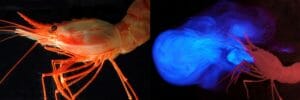Bioluminescence Definition
Bioluminescence (shown below) refers to organisms which produce and emit light as a form of chemiluminescence. This light can be produced both by the organisms themselves or via symbiotic bacterial strains. Bioluminescence results from a chemical reaction that occurs between a light-emitting molecule termed a luciferin and an enzyme called a luciferase. In general, the luciferin and luciferase differ between species, and bioluminescence has evolved independently in several species for different purposes.
Evolutionary Function of Bioluminescence
There are two dominant theories regarding the evolutionary function of bioluminescence:
- Mixed-function Oxygenase: It has been theorized that luciferases originated as mutations in mixed-function oxygenases that were evolutionarily selected for in dark marine environments, where the luminescence of tissues provided visual cues for mating or distracting predators.
- Protection against Reactive Oxygen Species: There is evidence that luciferins may have evolved as a protective measure against harmful reactive oxygen species (e.g., hydrogen peroxide). This theory postulates that bioluminescence was selected for as marine species moved into deeper, darker waters where the exposure to such reactive oxygen species was lower, as was the need for the endogenous production of such molecules.
Examples of Bioluminescence Functions
Since bioluminescence has evolved independently multiple times in multiple species, it has distinct functions in each species and depending on the environment.
Camouflage
In many species residing in the deep waters of the world’s seas and oceans, bioluminescence is used for counterillumination camouflage. This is achieved by photoreceptors in specialized light organs, which match the amount of light in the environment, effectively camouflaging the organism into the background when viewed from above. For example, several species of squid utilize this mechanism of bioluminescence.
Defense
In many species of phytoplankton, bioluminescence is used as a defense against predators. Since potential predators will release any phytoplankton species that emit light, it is thought that this trait evolved to detract predators who do not wish to attract predators themselves. This is further supported by the black stomach lining observed in predatory fish found in deeper waters, which prevents the glow from any bioluminescent organisms they have consumed. Some squid species use bioluminescent chemical secretions similar to the production of ink. Other squid species autotomize bioluminescent limbs that distract predators while the organism can flee to safety.
Attracting prey
Some species of fungus gnat reside within cave environments, and their larvae use bioluminescence to catch prey by dangling silk webs that emit a blue or green colored light. Such luminescence is even regulated by circadian rhythms and turns on and off at certain times of the day.
Visualization of Prey
Some species found in the ocean depths use red bioluminescence to visualize prey species that are red-colored, which is typically invisible in the deeper waters. In species, such as the dragonfish, their eyes are insensitive to the red bioluminescence they produce, instead visualizing their prey as a blue-green colour due to the presence of a specialized retinal pigment.
Attracting mates
Many insect species (e.g., fireflies and click beetles) use bioluminescence to attract potential mates. Similarly, many crustaceans use luminescence to provide a visual cue for potential mates whom they draw close with the production of pheromones. Many species use bioluminescence to attract prey by mimicking another species. Some deep-sea dwelling fish (e.g., anglerfish) have an appendage containing bioluminescent bacteria that it uses to attract prey. Some firefly species use the flashing patterns of other species to attract the males as prey.
Warning
Many species use bioluminescence as a warning to potential predators that they are not fit for consumption. Many insect larvae, jellyfish, and worm species exhibit this trait as a mechanism of detracting predators.
Communication
One common function of bioluminescence in bacterial and fungal species is to communicate cell density and the location of nearby bacterial colonies. Such genes are regulated by the concentration of secreted molecules in the environment.
Quiz
1. Which of the following is NOT a function bioluminescence:
A. Attract mates
B. Deter predators
C. Camouflage
D. Warning
E. All of the above are functions of bioluminescence
2. Which two components are required for bioluminescence?
A. Luciferin and luciferase
B. Illuminin and illuminase
C. Luminin and luminase
D. Luminin and Luciferase
References
- Warrant EJ and Locket NA. (2004). Vision in the deep sea. Luminescence. 79(3):671-712.
- Wilson T and Hastings J. (1998). Bioluminescence. Annu Rev Cell Dev Biol.14:197-230.

